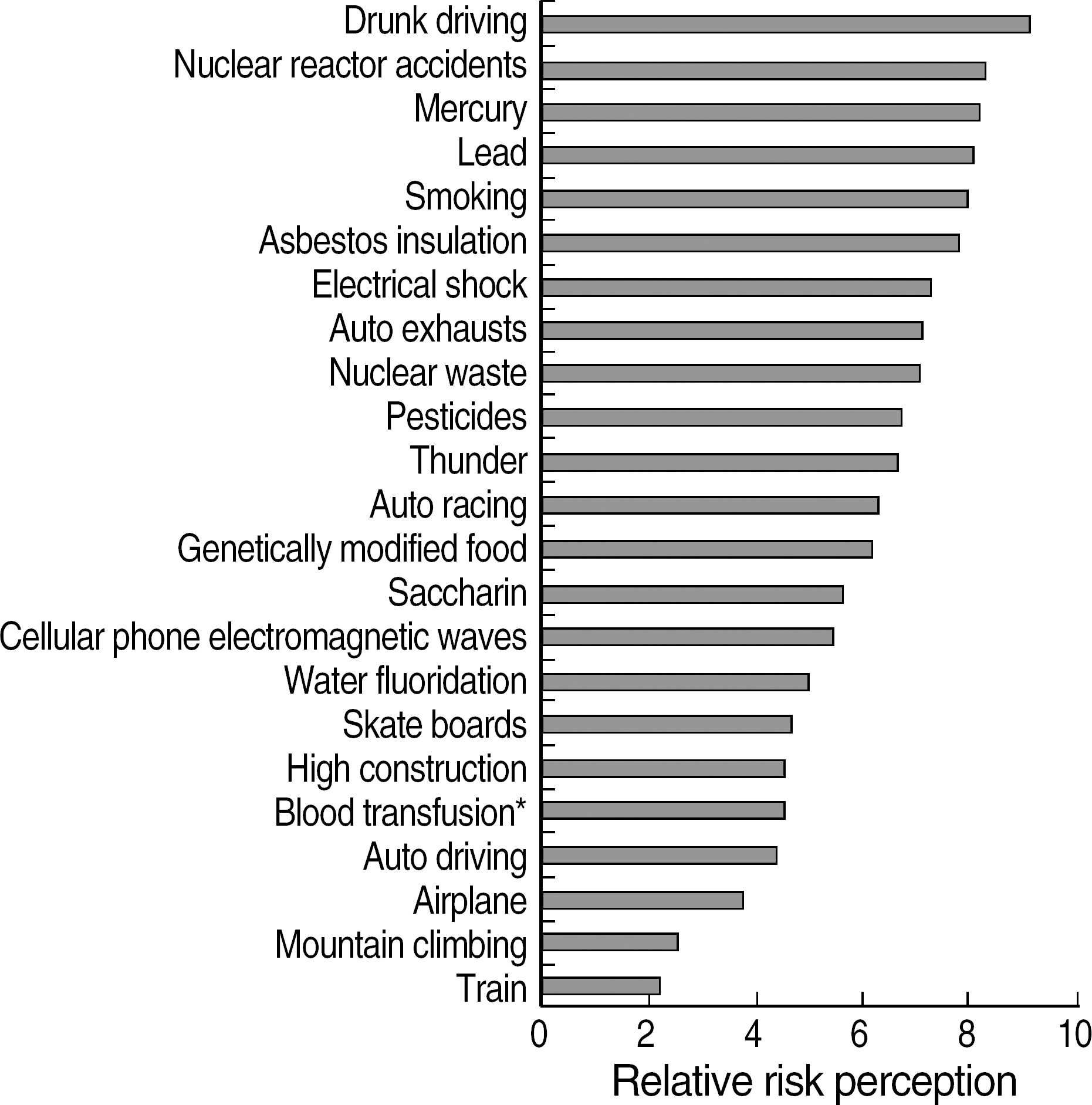Korean J Lab Med.
2009 Dec;29(6):570-577. 10.3343/kjlm.2009.29.6.570.
Perception of the Risks of Blood Transfusion in Koreans
- Affiliations
-
- 1Department of Laboratory Medicine, Seoul Paik Hospital, Inje University College of Medicine, Seoul, Korea.
- 2Department of Laboratory Medicine, Ilsan Paik Hospital, Inje University College of Medicine, Goyang, Korea. uthmd@paik.ac.kr
- 3Department of Preventive Medicine, Dankook University College of Medicine, Cheonan, Korea.
- KMID: 1781612
- DOI: http://doi.org/10.3343/kjlm.2009.29.6.570
Abstract
- BACKGROUND
The perceived risks of blood transfusions are important to be considered in creating a blood service policy. We surveyed the perception of blood transfusion risks among Korean laypeople. METHODS: A one-month nationwide telephone survey was conducted in September, 2007. The questionnaire was designed to assess the demographics of respondents, their responses to the term 'blood transfusion', and the perceived risks of a transfusion. A total of 500 interviews were completed. RESULTS: The words evoked by the term 'blood transfusion' included blood, donation, AIDS, help, and patients. About one third (33.6-35.8%) of the respondents gave a moderate to high rating for the perceived risks of blood transfusions. More than half (55.6%) of the respondents agreed that the blood supply in Korea is safe, and 81.6% of the respondents agreed to be transfused when transfusion is needed. The perceived risk of a blood transfusion was greater in women than in men and in people who never had a transfusion than those who had. More men than women agreed that the blood supply in Korea is safe, and the proportion of respondents who agreed to be transfused when needed was higher in men and in less educated people. The relative perceived transfusion risk (scale of 10) was 4.5+/-2.3. CONCLUSIONS: The Koreans in the survey had a tendency of positive thinking about blood transfusions, and previous transfusion experiences appear to decrease the fear about transfusions. These results will be useful in understanding how Koreans think about the risks associated with transfusions.
Keyword
MeSH Terms
Figure
Reference
-
1.Baek EJ., Kim HO., Kim S., Park QE., Oh DJ. The trends for nationwide blood collection and the supply of blood in Korea during 2002~ 2006. Korean J Blood Transfus. 2008. 19:83–90. (백은정, 김현옥, 김신영,박규은, 오덕자. 국내 헌혈 및 혈액공급의 변화(2002-2006년). ??????? 2008;19:83-90.).2.Kang JW., Lee JS., Seo DH., Huh K., Wee JH., Park Q. Characteristics and follow-up results of the window period blood donors for hepatitis C virus. Korean J Blood Transfus. 2007. 18:15–22. (강재원, 이재숙, 서동희, 허광, 위재호, 박규은. C형간염 바이러스 윈도우기 헌혈자의특성분석및추적조사결과. 대한수혈학회지 2007;18:15-22.).3.Lee JS., Yoon MJ., Kang JW., Kim JY., Seo DH., Park Q, et al. Characteristics of human immunodeficiency virus Type 1 reactive blood donors following nucleic acid amplification test screening. Korean J Blood Transfus. 2007. 18:202–8. (이재숙, 윤만정, 강재원, 김지연, 서동희,박규은 등. 핵산증폭검사에서 human immunodeficiency virus type 1양성결과를보인헌혈자의특성. 대한수혈학회지 2007;18:202-8.).4.Um TH., Whang DH., Park HD., Kim JH., Ha M., Cho NS. Cost-effectiveness of donor screening strategies for acitretin medication. Korean J Blood Transfus. 2008. 19:91–9. ((엄태현, 황동희, 박형두, 김장한, 하미나, 조남선. 헌혈금지약물 아시트레틴 복용 헌혈자 선별법의 비용-효과.대한수혈학회지 2008;19:91-9.).5.Finucane ML., Slovic P., Mertz CK. Public perception of the risk of blood transfusion. Transfusion. 2000. 40:1017–22.6.Finucane ML., Slovic P., Mertz CK. Bad blood or the elixir of life? Perceived risk of blood transfusions. Smit SCT, Alter HJ, editors. Risk management in blood transfusion: the virtue of reality. Dordrecht: Kluwer Academic Publishers;1999. p. 27–45.
Article7.Eurobarometer 41.0: Europeans and blood. Prepared for the European comission on employment, industrial relations and social affairs. Paris: Institut national de la Recherche Argonomique;1995.8.Bopp KF. The value of education to improve perception, acceptance and communication of transfusion related risk. Smit SCT, Alter HJ, editors. Risk management in blood transfusion: the virtue of reality. Dordrecht: Kluwer Academic Publishers;1999. p. 207–12.9.Lackritz EM., Satten GA., Aberle-Grasse J., Dodd RY., Raimondi VP., Janssen RS, et al. Estimated risk of transmission of the human immunodeficiency virus by screened blood in the United States. N Engl J Med. 1995. 333:1721–5.
Article10.Lee D. Perception of blood transfusion risk. Transfus Med Rev. 2006. 20:141–8.
Article11.Lee DH., Mehta MD., James PD. Differences in the perception of blood transfusion risk between laypeople and physicians. Transfusion. 2003. 43:772–8.
Article12.Lowe KC., Farrell K., Ferguson EM., James V. Current perceived risks of transfusion in the UK and relevance to the future acceptance of blood substitutes. Artif Cells Blood Substit Immobil Biotechnol. 2001. 29:179–89.
Article13.Slovic P. Perception of risk. Science. 1987. 236:280–5.
Article14.Slovic P., Flynn JH., Layman M. Perceived risk, trust, and the politics of nuclear waste. Science. 1991. 254:1603–7.
Article
- Full Text Links
- Actions
-
Cited
- CITED
-
- Close
- Share
- Similar articles
-
- Differences in the Perception of Blood Transfusion Risk between Laypeople and Transfusion Experts in Korea
- Transfusion practice in neonates
- Experience in Establishing Department of Transfusion Management
- Cancer Risk Perception and Cancer Related Health Behavior in College Students
- Guidelines for Appropriate and Safe Transfusion


